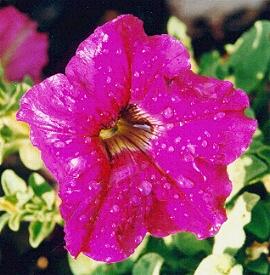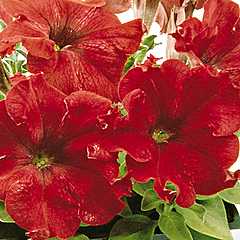|
Petunia
 Brightly
colored petunias are easy to grow and add an elegant touch to the
garden. Choose dwarf types to plant as edgings or use trailing
selections in hanging baskets or as colorful ground covers. Because
plant size and habit varies with selections, it is important to
check the plant tags. Petunias will grow in any well-drained soil
and plenty of sun is needed to help them flower well. Planted in
spring, petunias are capable of blooming through summer until the
first hard freeze in fall, but they will need regular snipping back
and feeding to keep them fresh. In areas without hard freezes,
petunias can also be planted in fall. Brightly
colored petunias are easy to grow and add an elegant touch to the
garden. Choose dwarf types to plant as edgings or use trailing
selections in hanging baskets or as colorful ground covers. Because
plant size and habit varies with selections, it is important to
check the plant tags. Petunias will grow in any well-drained soil
and plenty of sun is needed to help them flower well. Planted in
spring, petunias are capable of blooming through summer until the
first hard freeze in fall, but they will need regular snipping back
and feeding to keep them fresh. In areas without hard freezes,
petunias can also be planted in fall.
Care
 When planting
petunias in beds, cultivate the planting site at least 8 inches deep
and mix in a 2-inch deep layer of flower planting mix, compost, or
other type of organic matter. If your soil is heavy clay, also mix
in some sand to help it drain faster. Just before planting, mix in a
timed-release fertilizer with a high middle number, such as 11-40-6.
The extra phosphorous will help the plants develop extensive roots. When planting
petunias in beds, cultivate the planting site at least 8 inches deep
and mix in a 2-inch deep layer of flower planting mix, compost, or
other type of organic matter. If your soil is heavy clay, also mix
in some sand to help it drain faster. Just before planting, mix in a
timed-release fertilizer with a high middle number, such as 11-40-6.
The extra phosphorous will help the plants develop extensive roots.
Petunias often
benefit from cutting back in midsummer. Use sharp pruning shears to
cut off long, leggy stems and then fertilize the plants with
17-17-17 containing timed-release fertilizer. Sprinkle this "booster
feeding" into the soil between the plants and water well. When
growing petunias in containers, fertilize them more often by
sprinkling a teaspoon of fertilizer per plant atop the soil in the
pots about once a month.
|
